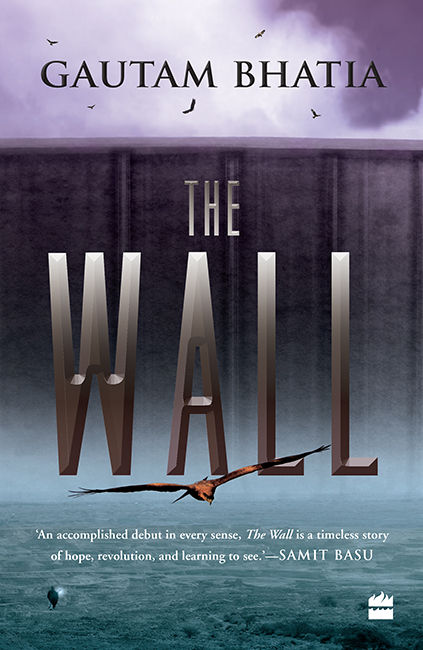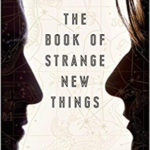Gautam Bhatia’s The Wall is an intricate and compelling cross between fantasy and fable that strikes at something deep within human nature, a yearning to break through the barriers that hem us in. In the world of The Wall, the barrier is a literal one, vast, black, blocking out every sign of a world beyond. It encloses a perfectly circular and symmetrical city called Sumer.
Created thousands of years ago by a supernatural race called the Builders, Sumer originally existed without a wall. But supposedly because of the transgression of a hero in Sumer’s early history, the Wall appeared all at once as a punishment for crossing the original boundary surrounding the city. Yet the Wall came to be revered with all the other works of the Builders as one of the things that made life in Sumer possible.
After dictatorship and rebellions in earlier times, Sumer came to be governed as a partial democracy, yet its real power, backed by force of arms (no elaborate weapons here, just clubs and bamboo blades), is a rigidly conservative priesthood that tries to stifle any signs of dissent.
The story focuses on a group of young dissenters, calling themselves the Young Tarafians after an earlier rebel of centuries past. They have pledged to breach the wall at all costs, even though they have no idea of what lies beyond its bounds. Their yearning to break free is such that any fate in the world beyond would be preferable to the suffocating and superficial perfection of life in Sumer.
Sumer and its culture are marvelous creations of this novel, deeply imagined in songs, poetry, food, ceremonies, physical symmetry, class structure, religion and politics. Yet all of that is only revealed bit by bit as the story and its characters gradually draw out more and more of the details of city life. It’s a great example of giving readers information only when they need to have it to understand the story and its characters.
Song and poetry are so deeply entwined in daily life of the young Tarafians that they often provide crucial insights at key points in their struggle to unravel the secrets of the city so that they can find a way to break out of its confines.
Mithila, the spokesperson of the group, is a singer, and Alvar, one of her closest friends is a poet. The novel is suffused with the songs and poems they perform. Many of these are ancient and so familiar that the secrets they contain only come out after repeated and ever closer penetration of their meanings.
Here is an idea of the role language plays in their lives. Spoken by Mithila’s brother Garuda, the charismatic leader of the Tarafians who disappears during an early attempt to breach the Wall:
‘I dreamt of a new language. A language that would be free. New words with which we could … draw all that we would see beyond the Wall. Taste it. We would dream in our new language. Here in Sumer, words are a pale reflection of things as they are. As they should be. But there, beyond the Wall, words would be alive. Breathing. Real.’
The Wall, Kindle edition, Location 245
Echoes of Plato’s cave are clear, yet Plato had little use for poets in his republic. Here the power of language to shape the boundaries of life is a powerful theme of the novel, given life by dozens of lyrics and poems that carefully match the yearnings and ideals of Mithila and her friends.
Weary of days marked by “Wallrise” and “Wallset” instead of reference to the sun, Mithila addresses the failure of imagination to “see” anything beyond that dark barrier. That is why poetry and song are so important. They appeal to the feelings as well as the mind to provoke dreams of what could exist in the wider world.
In fact, one of the beautiful climactic moments turns on a mystery, the search for the true meaning of a key word that can unlock the motivation of the people to change and rebel.
And rebellion is much in the air of Sumer. It is a city with a rigid class structure. It consists of fifteen communities, formed as mandalas, with the rich and powerful clustered in the first five near the hub of community and governmental life. Each of the others has its specific function and tradition, but the housing and lives get progressively poorer until they reach the Dooma, a warren of hovels and dark alleys.
Life and time are described by the religious leaders as circular and perfect, like the Wall and the city itself, as decreed by the Builders and the books they have left behind. Gautam Bhatia is a lawyer and constitutional scholar in India, and his experience has fed into the political and class ideas so important to this story. Those ideas are worked into highly dramatic scenes capturing the social turmoil and raging discontent just below the surface.
Mithila becomes a leading voice of this discontent. She speaks her mind in public, challenges the political leaders and in her struggle to find a way through the Wall explores one forbidden part of the city after another. She encounters amazing secrets which deepen the mystery surrounding the origins of Sumer but also begin to reveal ways by which an escape might be achieved. The story builds to an exciting climax that perfectly sets the stage for a second book in the Chronicles of Sumer.
I read this book in the Kindle edition, and my one criticism of this format is that the map provided at the beginning is so compressed as to be unreadable. I had to go online and look at the full size image using the “Look Inside” feature on the Kindle website. I recommend doing that if you are limited to this edition since it is hard otherwise to get an accurate picture of the physical layout without it. It’s important to see that right away. Other than that problem, I love this book and hope to see the next volume soon.



Leave a Reply